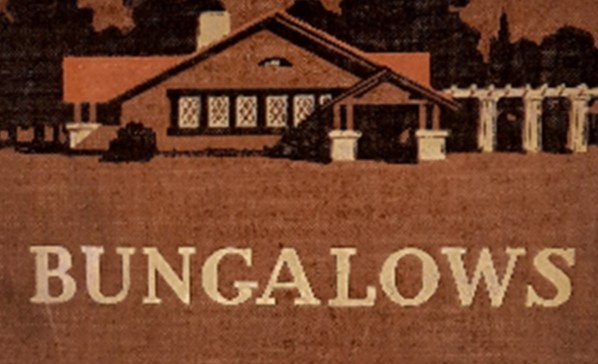By Ed McDevitt, Class of 2010
 The Barry Sears Volunteer Library Committee members have embarked on a series of essays about the books in our library to be published on The Bridge. I decided, being the most senior of the members, to focus on the oldest books in the library.
The Barry Sears Volunteer Library Committee members have embarked on a series of essays about the books in our library to be published on The Bridge. I decided, being the most senior of the members, to focus on the oldest books in the library.
When I began to look at our oldest books, I expected to find them merely quaint, as, I suspect, some people find me. Our oldest book belies that expectation. It is Bungalows: Their Design, Construction and Furnishing, with Suggestions also for Camps, Summer Homes and Cottages of Similar Character by Henry H. Saylor, published in 1911 (Library of Congress # NA7120.S). It has an owner stamp on the flyleaf:
J. O. Cederberg, Jr.
Architect
404-405 Endicott Bldg. (handwritten)
In the 1900 U.S. census, John O. Cederberg, a Swedish immigrant, is a 16-year-old “student architect.” By the 1920 Census he is a naturalized citizen with his own architecture practice and a family, including two young children.
Henry Hodgman Saylor (1880-1967) was the author or editor of a number of books, including Country Houses, Inexpensive Homes of Individuality, Making a Fireplace, and Tinkering with Tools. He studied architecture at MIT, was a Fellow of the American Institute of Architects, and became editor of Architectural Review in 1904. He created the first AIA Dictionary of Architecture in 1952.
Encyclopedia Britannica defines a bungalow as a “single-storied house with a sloping roof, usually small and often surrounded by a veranda. The name derives from a Hindi word meaning “a house in the Bengali style’ and came into English during the era of the British administration of India. The style . . . gained popularity in housing developments of American towns during the 1920s. Its general design —with high ceilings, large doors and windows, and shade-giving eaves or verandas — makes it especially well suited for hot climates, and bungalows are still frequently built as summer cottages or as homes in warm regions such as southern California.”
Mr. Saylor, however, says:
The term “Bungalow” provides a curious example of how we Americans overwork a word that is euphonious and the meaning of which, because of the word’s comparatively recent assimilation into the language, is somewhat uncertain. One hears nearly every type of country or suburban home called a bungalow, provided only that the house is somewhat informal or picturesque in its lines. Someone has facetiously remarked that in the new dictionaries a bungalow should be defined as “a house that looks as if it had been built for less money than it actually cost. . . .”
In adapting this type of building to our own needs, we realize at the very outset that there are forces working against the adoption of the true bungalow characteristics. One of these is the element of cost; a building with all its rooms upon the ground floor is the most expensive to build. There is more wall surface and roof area in proportion to the enclosed space than in a building of two or more stories.
Saylor describes many possible features of the proper bungalow in this richly illustrated volume. He divides American bungalows into ten types and describes the differences in bungalows for the seacoast, the woods and the hills. He also details various plans for the homes, along with the proper foundations, wall materials, and roofing materials and is adamant about having a fireplace in a self-respecting bungalow: “A bungalow without a fireplace would be almost as much of an anomaly as a garden without flowers – and as cheerless.” The later chapters of the book concern themselves with furniture, lighting systems, water supply, sewage disposal and plantings.
Sadly, the book’s binding is deteriorating and the heavy paper on which it is printed, likely not acid-free, is brittle. Let’s keep in mind that this first edition is 111 years old, so its condition should not be a surprise.
______________________________________________________________________________

CLICK HERE for more stories on The Bridge.


I’ve always admired bungalows – so nice to learn more about them.
Thanks, Ed. 111 years old? Isn’t that ironic that it now rests at 111 Wacker Dr? Thanks for the overlook. Like Marcia, I’ve always admired bungalows and think their value in the development of Chicago is underrated.
You are not just quaint, Ed, you are rare and vintage (as are many of us). I’m wondering about the symbol on the book’s cover. that looks like a swastika. Since the book pre-dates WWII, it can have nothing to do with the Nazis. Do you know what it is and if it has a special meaning?
Bungalows are so important to the development of Chicago neighborhoods for families. Ed, thank you for the interesting article. I agree with Emily, you are not quaint, but seasoned, smart, sharing, and a super docent.
I’m also interested in the swastica on the cover. I know it is an old religious symbol of a sort but what’s it doing on that book? This is a really nice article fir me as I occupied a Chicago Bungalow for 23 years!
Yes, very interesting. The hooked cross on the cover goes back, way back. I found this from the Holocaust encyclopedia “In the beginning of the twentieth century the swastika was widely used in Europe. It had numerous meanings, the most common being a symbol of good luck and auspiciousness.”